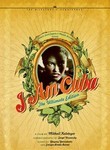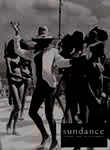A movie about a movie about Cuba
 When I began writing about Cuba in addition to reading a lot of material I also rented some movies. One of the films I saw was Soy Cuba (I am Cuba). Soy Cuba is a communist propaganda film made between 1962 and 1964 by a Cuban/Soviet film crew. It's supposed to show the decadence of pre-castro Cuba and how the righteous Cuban people rose up in Revolution. At the time the film was released in both countries it was considered a failure. It was panned by critics in Cuba who called it "I am not Cuba" because of the alien vision it transmitted and was pulled from Soviet theaters because of the "dangerous" images of American materialism that it contained.
When I began writing about Cuba in addition to reading a lot of material I also rented some movies. One of the films I saw was Soy Cuba (I am Cuba). Soy Cuba is a communist propaganda film made between 1962 and 1964 by a Cuban/Soviet film crew. It's supposed to show the decadence of pre-castro Cuba and how the righteous Cuban people rose up in Revolution. At the time the film was released in both countries it was considered a failure. It was panned by critics in Cuba who called it "I am not Cuba" because of the alien vision it transmitted and was pulled from Soviet theaters because of the "dangerous" images of American materialism that it contained.
The movie collected dust until 1995 when it was rediscovered by Martin Scorsese and Francis Ford Coppola, who introduced it to American audiences. The most remarkable thing about the film is the stunning photography. There are long uncut scenes not seen anywhere before or since, with long tracking shots using dollies and cable rigs. Describing it is difficult.
In 2001 Brazilian filmmaker Vicente Ferraz went to Cuba to interview the surviving crewmembers of I am Cuba to make a documentary. In his words he wanted to make a movie about how that movie was made from a technical standpoint, but came away with a human story about cultures colliding and, at times, truly misunderstanding each other.
In the beginning of the documentary, the Cubans recounting their stories are indifferent and embarrassed about their participation in making I am Cuba because it had been branded as a colossal failure. They do however look back nostalgically on the period as a period of hope and exciting changes. But Ferraz shows that by 2001 these same people had been beaten down, resigned to the fact that the Cuban Revolution had failed. Then something interesting happens, when Ferraz shows each of the protagonists the critical acclaim that I am Cuba had gotten in the United States 30 years after it was made (and 5 years before their interviews). You can see their moods change as if their lives had just been given some sort of meaning by learning of their previously unknown accomplishment. They are proud that someone thought enough of their work to come all the way from Brazil to ask them questions about it.
The name of Ferraz' documentary is I am Cuba, the Siberian Mammoth, an interesting title to be sure, but at the end of the movie we learn its meaning. According to Ferraz I am Cuba is like an archaeological find. Like finding a Siberian Mammoth in Caribbean sands. I highly recommend the documentary. You don't have to see I am Cuba to enjoy this film. In a certain way, even though it’s a movie that praises a communist propaganda film, we see failures of the Revolution illustrated very clearly.
I highly recommend the documentary. You don't have to see I am Cuba to enjoy this film. In a certain way, even though it’s a movie that praises a communist propaganda film, we see failures of the Revolution illustrated very clearly.
The archival footage, photographs and scenes of I am Cuba that are used in Siberian Mammoth clearly contrast with the modern footage of Havana that Ferraz shot. In 1962, Cuba still looked a lot like it did in 1958: a modern beautiful city with well-dressed people and shiny new cars. By contrast we see the dilapidated buildings and the looks of resignation in the eyes of the modern-day Cubans. In fact, Ferraz takes us to some of the locations 40 years after the filming and we see, for example, what was once a beautiful swimming pool on the top of a glamorous hotel is now empty and abandoned, all of it's former grandeur now gone.
Although I am staunchly anticommunist and anti-castro, one has to acknowledge an impressive work of art when one sees it. Like Leni Riefenstahl's Triumph of the Will, I am Cuba should be seen as a lesson in powerful filmmaking, but Ferraz' Siberian Mammoth is an even better lesson in how to make a documentary.

No comments:
Post a Comment